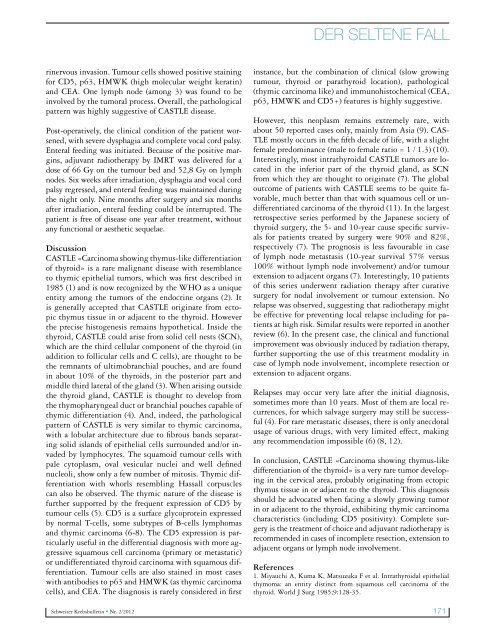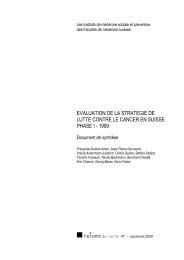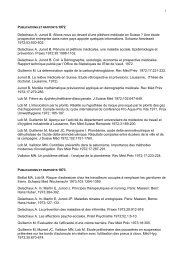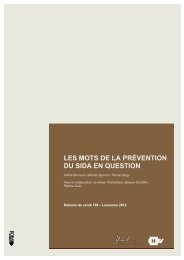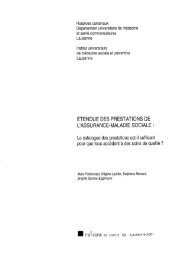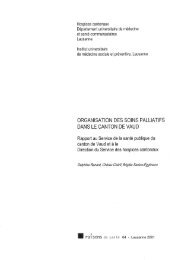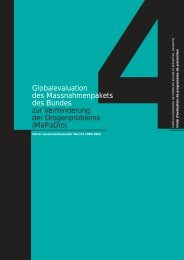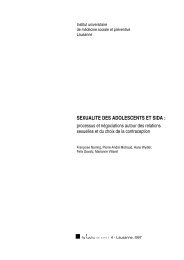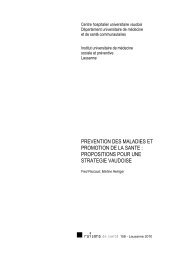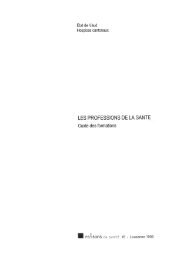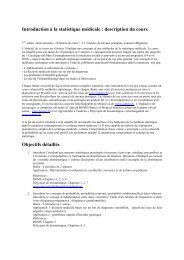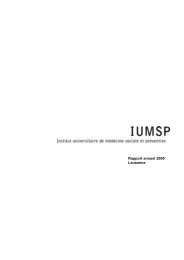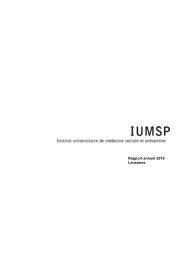Fortbildungen / Formations continues 2012 - IUMSP
Fortbildungen / Formations continues 2012 - IUMSP
Fortbildungen / Formations continues 2012 - IUMSP
Erfolgreiche ePaper selbst erstellen
Machen Sie aus Ihren PDF Publikationen ein blätterbares Flipbook mit unserer einzigartigen Google optimierten e-Paper Software.
inervous invasion. Tumour cells showed positive staining<br />
for CD5, p63, HMWK (high molecular weight keratin)<br />
and CEA. One lymph node (among 3) was found to be<br />
involved by the tumoral process. Overall, the pathological<br />
pattern was highly suggestive of CASTLE disease.<br />
Post-operatively, the clinical condition of the patient worsened,<br />
with severe dysphagia and complete vocal cord palsy.<br />
Enteral feeding was initiated. Because of the positive margins,<br />
adjuvant radiotherapy by IMRT was delivered for a<br />
dose of 66 Gy on the tumour bed and 52,8 Gy on lymph<br />
nodes. Six weeks after irradiation, dysphagia and vocal cord<br />
palsy regressed, and enteral feeding was maintained during<br />
the night only. Nine months after surgery and six months<br />
after irradiation, enteral feeding could be interrupted. The<br />
patient is free of disease one year after treatment, without<br />
any functional or aesthetic sequelae.<br />
Discussion<br />
CASTLE «Carcinoma showing thymus-like differentiation<br />
of thyroid» is a rare malignant disease with resemblance<br />
to thymic epithelial tumors, which was �rst described in<br />
1985 (1) and is now recognized by the WHO as a unique<br />
entity among the tumors of the endocrine organs (2). It<br />
is generally accepted that CASTLE originate from ectopic<br />
thymus tissue in or adjacent to the thyroid. However<br />
the precise histogenesis remains hypothetical. Inside the<br />
thyroid, CASTLE could arise from solid cell nests (SCN),<br />
which are the third cellular component of the thyroid (in<br />
addition to follicular cells and C cells), are thought to be<br />
the remnants of ultimobranchial pouches, and are found<br />
in about 10% of the thyroids, in the posterior part and<br />
middle third lateral of the gland (3). When arising outside<br />
the thyroid gland, CASTLE is thought to develop from<br />
the thymopharyngeal duct or branchial pouches capable of<br />
thymic differentiation (4). And, indeed, the pathological<br />
pattern of CASTLE is very similar to thymic carcinoma,<br />
with a lobular architecture due to �brous bands separating<br />
solid islands of epithelial cells surrounded and/or invaded<br />
by lymphocytes. The squamoid tumour cells with<br />
pale cytoplasm, oval vesicular nuclei and well de�ned<br />
nucleoli, show only a few number of mitosis. Thymic differentiation<br />
with whorls resembling Hassall corpuscles<br />
can also be observed. The thymic nature of the disease is<br />
further supported by the frequent expression of CD5 by<br />
tumour cells (5). CD5 is a surface glycoprotein expressed<br />
by normal T-cells, some subtypes of B-cells lymphomas<br />
and thymic carcinoma (6-8). The CD5 expression is particularly<br />
useful in the differential diagnosis with more aggressive<br />
squamous cell carcinoma (primary or metastatic)<br />
or undifferentiated thyroid carcinoma with squamous differentiation.<br />
Tumour cells are also stained in most cases<br />
with antibodies to p63 and HMWK (as thymic carcinoma<br />
cells), and CEA. The diagnosis is rarely considered in �rst<br />
DER SELTENE FALL<br />
instance, but the combination of clinical (slow growing<br />
tumour, thyroid or parathyroid location), pathological<br />
(thymic carcinoma like) and immunohistochemical (CEA,<br />
p63, HMWK and CD5+) features is highly suggestive.<br />
However, this neoplasm remains extremely rare, with<br />
about 50 reported cases only, mainly from Asia (9). CAS-<br />
TLE mostly occurs in the �fth decade of life, with a slight<br />
female predominance (male to female ratio = 1 / 1.3) (10).<br />
Interestingly, most intrathyroidal CASTLE tumors are located<br />
in the inferior part of the thyroid gland, as SCN<br />
from which they are thought to originate (7). The global<br />
outcome of patients with CASTLE seems to be quite favorable,<br />
much better than that with squamous cell or undifferentiated<br />
carcinoma of the thyroid (11). In the largest<br />
retrospective series performed by the Japanese society of<br />
thyroid surgery, the 5- and 10-year cause speci�c survivals<br />
for patients treated by surgery were 90% and 82%,<br />
respectively (7). The prognosis is less favourable in case<br />
of lymph node metastasis (10-year survival 57% versus<br />
100% without lymph node involvement) and/or tumour<br />
extension to adjacent organs (7). Interestingly, 10 patients<br />
of this series underwent radiation therapy after curative<br />
surgery for nodal involvement or tumour extension. No<br />
relapse was observed, suggesting that radiotherapy might<br />
be effective for preventing local relapse including for patients<br />
at high risk. Similar results were reported in another<br />
review (6). In the present case, the clinical and functional<br />
improvement was obviously induced by radiation therapy,<br />
further supporting the use of this treatment modality in<br />
case of lymph node involvement, incomplete resection or<br />
extension to adjacent organs.<br />
Relapses may occur very late after the initial diagnosis,<br />
sometimes more than 10 years. Most of them are local recurrences,<br />
for which salvage surgery may still be successful<br />
(4). For rare metastatic diseases, there is only anecdotal<br />
usage of various drugs, with very limited effect, making<br />
any recommendation impossible (6) (8, 12).<br />
In conclusion, CASTLE «Carcinoma showing thymus-like<br />
differentiation of the thyroid» is a very rare tumor developing<br />
in the cervical area, probably originating from ectopic<br />
thymus tissue in or adjacent to the thyroid. This diagnosis<br />
should be advocated when facing a slowly growing tumor<br />
in or adjacent to the thyroid, exhibiting thymic carcinoma<br />
characteristics (including CD5 positivity). Complete surgery<br />
is the treatment of choice and adjuvant radiotherapy is<br />
recommended in cases of incomplete resection, extension to<br />
adjacent organs or lymph node involvement.<br />
References<br />
1. Miyauchi A, Kuma K, Matsuzuka F et al. Intrathyroidal epithelial<br />
thymoma: an entity distinct from squamous cell carcinoma of the<br />
thyroid. World J Surg 1985;9:128-35.<br />
Schweizer Krebsbulletin � Nr. 2/<strong>2012</strong> 171


